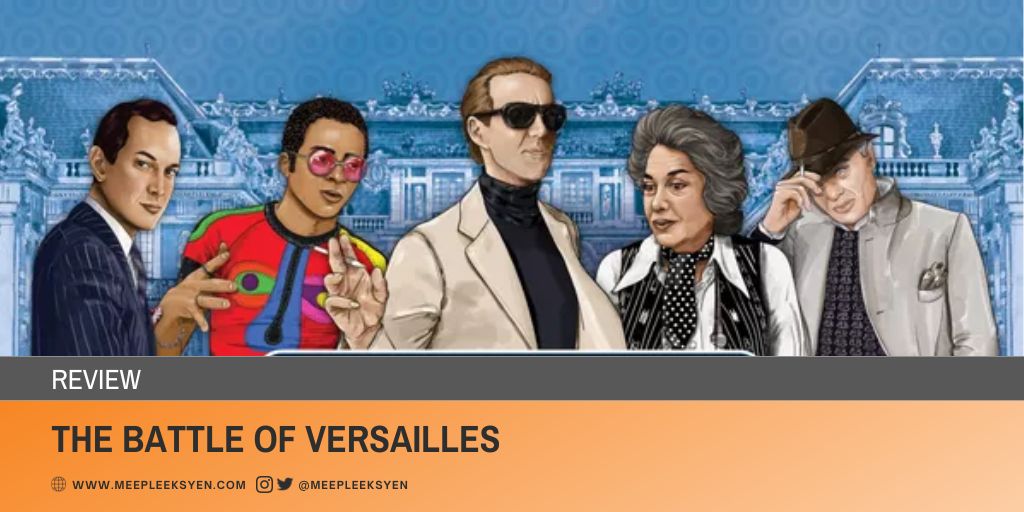While we’re at it: This game will be live on Gamefound. Visit and follow their project page!
The year is 1973. And the grand Versailles Palace faced the daunting challenge of raising funds for its much-needed restoration. Financially, it appeared to be an insurmountable task. A labour of Hercules. Until Eleanor Lambert and Gerald van der Kemp conceived an undeniably great idea that would go down in history.
The Battle of Versailles Fashion Show was born. This particular project has propelled Lambert to her legendary status, adding to her already impressive, long CV. Let’s not forget her iconic New York Fashion Week, and the celebrated Met Gala.
Eloi Pujadas and Ferran Renalias are ambitiously reconstructing the historic Battle of Versailles. They condensed this grand 5v5 designer showdown into a two-player format, showcasing the renowned fashionista from both French and US sides. Even such individuals less well-versed with high fashion, like myself, can recognize the celebrated names in this game. I mean, who doesn’t know Yves Saint Laurent? Or Pierre Cardin. Oscar de La Renta. And many more mentioned in The Battle of Versailles.
The two-player fashion showdown unveiled
A fashion show thrives on three essential elements: The celebrities and their glitz, the drama, and of course, the dazzling arrays of dresses. And just like that, it was the rudiments of The Battle of Versailles. Both designers have translated these aspects into this card-based game seamlessly.
With that being said, the game prominently revolves around its card-based mechanic. Despite employing this battle-card-driven mechanic, The Battle of Versailles sets itself apart from other games in this category. It brings another tone to the classification.
The French and US factions wield their individual decks of cards, becoming the conduits to the same goal: victory. Every card falls into distinct three categories. And these categories refer to the aforementioned three principles in a fashion show. Thus, each should be played differently to get some advantages.
Alternatively, thanks to their multifunctional capabilities, players have the option to discard them to obtain resources. In this case, it means money. Or possibly more cards.
This mechanic is, as we know, often a hallmark of historical wargames. Such games that actually depict significant battles between two warring states—something more familiar for the gamers.
And to be clear, The Battle of Versailles certainly carries notable historical weight through its fashion showdown. Yet, the battle feels milder – which is a good thing – and more family-friendly compared to other games with a similar way of playing. This showdown did not aim to reshape the global political landscape, nor depict the horrors of war. For me, this feels like a breath of fresh air.
An insight into The Battle of Versailles’ gameplay
Yet, the path to the fashion triumph varies. Each faction has their independent conditions to win the showdown. As I anticipated, actually. The Battle of Versailles has once again adopted an asymmetric approach. A reminiscence of Eloi’s approach in Troia.
The fashion face-off materializes on the catwalk. This is a vivid representation, mirroring the real eventuality. We have the catwalk illustrated through multiple square tiles. Each activates specific actions, culminating in front of the Palace of Versailles. When the model reaches the last tile, it marks the conclusion of each round.
The asymmetrical approach
From the outset, the US faction grapples with challenging odds. Allotted with fewer actions than their French counterparts, the American designers need to strive to amass reputation within their constrained timeframe. Yet, this does not translate to an easy victory for Yves and co., though. Their primary focus, still and will always, lays in the restoration of Versailles. And the latter one means more money involved.
With divergent objectives in mind, both side adopt distinct tactical approaches over the five rounds. Both have different definition of triumph in their dictionary.
While the US fervently showcases diverse dresses, aiming to steal the spotlight across different categories, the French are more committed to securing funding for the palace rebuild. The idea of contributing less money than the US is a no-go. The whole nation would lose face.
The surprise factors—let there be drama among celebrities
Wherever a fashion show unfolds, there inevitably follows a string of contentious occurrences. Especially in an event as big as this showdown.
And these Event cards are capable of altering the course of the fashion show, potentially delivering a setback to the opposing party. For instance, some of them could swap the catwalk tiles. As a result, the model does not walk through a tile, skipping that turn, disrupting the opponent’s momentum.
This direct implementation of the take-that mechanic may not be everyone’s cup of tea. Particularly for those like me. I am actually averse to conflict. Nonetheless, these event cards effectively recreate the tense atmosphere of the fashion show. Alongside the introduction of influential celebrities, capable of shifting the mood of the showdown.
Verdict
If you’re curious about the outcome: The Battle of Versailles mirrored a classic David versus Goliath showdown. The French, naturally, assumed the role of the latter. Despite being the underdogs, the US fashion designers managed to captivate the audience with their fresh ideas, securing a symbolic victory by showcasing their dresses within the allocated 30-minute window.
Playing as the US faction feels relatively easier than their French counterparts. Surprising, I know. The latter has a surplus of actions at their disposal, that’s obvious by only glancing at the catwalk. Yet, their victory conditions were notably more challenging.
Nonetheless, the game maintains a commendable balance, as our gaming sessions witnessed a fairly even distribution of victories and losses between all designers from the two nations.
The Battle of Versailles stands as an exemplary game that checks all the boxes for me. From mere personal preferences, like the two-player format, to the intricacies provided by its gameplay and mechanics. While it doesn’t bring warfare to the tabletop, Eloi and Ferran have successfully crafted an impressive two-player wargame.
Do you love board games as much as we do? Support us!
Thank you for reading our articles! If you enjoyed our work and want more captivating board game contents, make sure to:
👉 Follow us on our social media — you can find us on ![]()
![]()
![]() Click one of the icons to land on our social media, or find us @meepleeksyen there, it’s just a click away! Stay updated with our latest board game reviews and previews by following us on those platforms 📱👍
Click one of the icons to land on our social media, or find us @meepleeksyen there, it’s just a click away! Stay updated with our latest board game reviews and previews by following us on those platforms 📱👍
💬 Do you have contrasting opinions? Leave a comment — share your thoughts with us, we’d love to hear (or read) yours! Have you played this game before? Did you have something similar as well? Or perhaps, something more personal, like what are your favourite board games? Let’s discuss in the comments below!
🙏 Support Us! Your generous support can help us produce even better content in the future. If you love what we do, consider making a donation to our blog. Every contribution counts and means a lot to us! You can either donate locally with Indonesian Rupiah (IDR) via Trakteer ![]() or for international readers with another currency through Buy Me a Coffee
or for international readers with another currency through Buy Me a Coffee ![]() It helps us to survive, too! 💰 Click one of the button below 👇
It helps us to survive, too! 💰 Click one of the button below 👇
I am a full-time food technologist during weekdays. However, when the calendar hits weekends, I transform into an avid board gamer. I am a hardcore Legend of the Five Rings (L5R) LCG player from Fantasy Flight Games (FFG). Current hobby: buying board games. My shelf of shame’s list is getting longer, thanks to you, Kickstarter.





